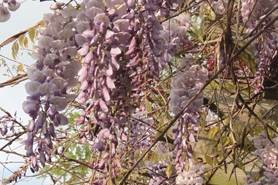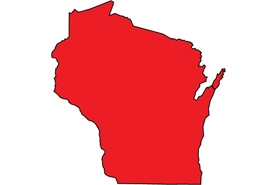Japanese Wisteria; Chinese Wisteria
(Wisteria floribunda; Wisteria sinensis)
Ornamental perennial vine in the legume family with lavender-colored clusters of pea-like flowers.
Other names for Japanese Wisteria, Wisteria floribunda, include:
- Common names: fuji; Noda-fuji; Chinese wisteria
- Scientific names: Kraunhia floribunda, Rehsonia floribunda, Glycine floribunda
Other names for Chinese wisteria, Wisteria Sinensis include:
- Scientific names: Rehsonia floribunda
Classification in Wisconsin: Prohibited
- Ecological Threat
-
Genetic analyses have shown that most naturalized plants are Chinese and Japanese wisteria hybrids. Two studies in the southeastern U.S. found 82-96% of wisteria collections were hybrids of W. sinensis and W. floribunda (W. x formosa).
Ecological threat:- Invasive in similar climate zones; Mid-Atlantic states and southeast from Tennessee to South Carolina and north to New Jersey, Connecticut, Illinois and Pennsylvania.
- Regeneration of trees and understory vegetation is decreased by smothering and shading. Wisteria vines can climb over existing vegetation and topple large trees, creating canopy gaps that further favor infestations.
- Infestations have been reported in all successional forest phases and occupy diverse forest types.
- Roots form a symbiotic relationship with the nitrogen-fixing bacterium Rhizobium. Large infestations may increase nitrogen fixation of soil, altering soil chemistry.
- Wisteria has a broad distribution and expanding range with diverse plant community associations.
- Long-lived vines grow into dense infestations, spreading from horticultural plantings.
- Identification
-
Leaves & stems: Woody vines with alternate, pinnately compound leaves about one foot long. Leaves have slightly wavy margins. Older vines can reach a diameter of over 15 inches.
Flowers: Showy and fragrant pea-like flowers borne on large, dangling racemes (clusters). Lavender to blue-violet in color.
Fruits & seeds: Velvety seed pods, brownish to gold in color. Pods are 4-6 inches long, narrowing at the base and constricting each root. The brown seeds are round and flat, 1-8 per pod.
Roots: Few large, deeply rooted. Plants also have runners or stolons that run horizontally across the ground, which gives rise to new plants.
Similar species: American wisteria, Wisteria frutescens, is native to the southeast United States. Flower clusters are minormaller and seed pods are smooth, not velvety. This species is not commonly reported in the nursery trade.
- Control
-
Combining control treatments (manual, mechanical, chemical) is often the most effective and reduces potential negative impacts.
Mechanical:- Cutting is effective in suppressing the strangulation of desired plantings. This is most effective on smaller populations or as preliminary treatment for impenetrable populations. Plants resprout after injury, so continual cutting is required to exhaust root reserves eventually.
- Fire as a means of control is a more significantreater research. For more information on using prescribed fire as a control for wisteria, visit the USDA Forest Service, Fire Management Considerations.
- Cut-stump application of glyphosate or triclopyr haspracticalective for large vines. Foliar applications are most effective for seedlings.
- Recommended foliar herbicide procedures (from Miller, 2003):
- Thoroughly wet all leaves with one of the following herbicides in water with a surfactant.
- July to October for successive years when regrowth appears -- Tordon 101 as a 3% solution (12 ounces per 3-gallon mix), Tordon K as a 2% solution (8 ounces per 3-gallon mix), or Garlon 4 as a 4% solution (15 ounces per 3-gallon mix).
- July to September for successive years when regrowth appears --Transline as a 0.5% solution in water (2 ounces per 3-gallon mix) when safety to surrounding vegetation is desired.
- September to October with repeated applications --glyphosate as a 2% solution (8 ounces per 3-gallon mix).
- Resources
- Sources for content:
- U.S. Department of Agriculture, Forest Service
- Miller, James H. 2003. Nonnative invasive plants of southern forests: a field guide for identification and control. Gen. Tech. Rep. SRS–62. Asheville, NC: U.S. Department of Agriculture, Forest Service, Southern Research Station. 93 p.
- Stone, Katharine R. 2009. Wisteria floribunda, W. Sinensis. In: Fire Effects Information System, [Online]. U.S. Department of Agriculture, Forest Service, Rocky Mountain Research Station, Fire Sciences Laboratory (Producer). Available: http://www.fs.fed.us/database/feis/ [2013, July 29].
- Trusty, J. L.; Lockaby, B. G.; Zipperer, W. C.; Goertzen, L. R. 2007. Identity of naturalized exotic Wisteria (Fabaceae) in the southeastern United States. Weed Research.
- Trusty, Jennifer L.; Goertzen, Leslie R.; Zipperer, Wayne C.; Lockaby, B-Graeme. 2007. Invasive Wisteria in the Southeastern United States: genetic diversity, hybridization, and the role of urban centers. Urban Ecosystems. 10(4): 379-395.


